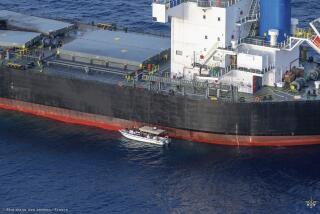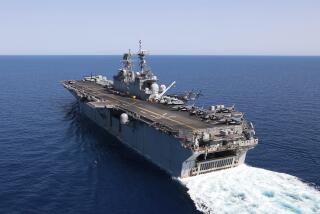Convoy Passes Through Strait : Tankers Safely Into Gulf, Now Beyond Iran Missile Range
- Share via
WASHINGTON — The first convoy of U.S. Navy-escorted Kuwaiti oil tankers made it safely through the Strait of Hormuz and into the Persian Gulf, beyond the range of Iranian Silkworm missiles in the most hazardous part of its initial journey, the Pentagon said today.
The convoy is expected to arrive at the Kuwaiti oil terminal of Al Ahmadi on Friday morning, Pentagon spokesman Robert Sims said.
“There is a still a risk involved in the rest of the mission and the relief will come Friday,” Sims said.
But for now, “we’re relieved that they’re out of the Silkworm missile envelope,” Sims said after the 11 a.m. PDT passage of the five-ship convoy consisting of two tankers and three warships through the strait.
The envelope covers the 50-mile range of the Chinese-made mobile missiles, which are armed with 1,000-pound explosive warheads with enough range to menace any ship sailing through the strait.
The convoy was now cutting southwest from Iran to hug the coast of the United Arab Emirates, Sims said.
The only serious incident occurred when a helicopter chartered by the media came within 1,000 yards of the guided missile destroyer Kidd and the ship had to warn it away by firing a flare, Sims said. The helicopter then clattered off.
There were no displays of hostile intent toward the convoy either by Iranian aircraft or ships throughout the eight-hour passage of the U.S. warships and the tankers Bridgeton and Gas Prince through the 30-mile-wide, horseshoe-shaped strait, Sims said.
The spokesman added that U.S. forces had detected a small number of Iranian airplanes conducting routine patrols near the strait as the ships passed through the area, but the Iranian aircraft made no move toward the vessels.
“This is the first mission and we’re happy that it’s going as well as it is,” Sims said.
Only two of the 11 Kuwaiti oil and gas tankers have been reflagged, and the next escort operation will take place after the Bridgeton and Gas Prince load up and head southward through the gulf. Sims said he did not have a scheduled departure of the ships from Kuwait.
Other potential threats include terrorist-type attacks from small boats or rubber dinghies that Sims said have been used in 17 known strikes against shipping in the gulf since February.
Sims said the convoy was closely shadowed throughout its transit through the strait by jet aircraft from the carrier Constellation, which is steaming outside the gulf in the northern Arabian Sea.
At the moment, he said, the convoys are under constant aerial surveillance by a Saudi Arabian AWACS radar plane.
More to Read
Sign up for Essential California
The most important California stories and recommendations in your inbox every morning.
You may occasionally receive promotional content from the Los Angeles Times.










